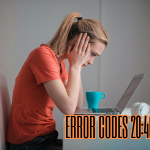Introduction: In the realm of coding and programming, understanding semantic errors is paramount. They lurk beneath the surface, causing confusion and hindering progress. Among these, semantic error chapter 79 stands out, often puzzling even the most seasoned developers. But fear not, as we embark on a journey to demystify this enigmatic chapter. From its definition to practical examples, we’ll unravel its complexities and equip you with the knowledge to navigate it with confidence.
Semantic Error Chapter 79: Deciphering the Code
In the world of programming, semantic errors are akin to hidden traps, waiting to thwart your progress. Semantic error chapter 79 is one such enigma, characterized by its elusive nature and perplexing manifestations. Understanding its intricacies is essential for any coder striving for mastery.
The Origins of Semantic Error Chapter 79
Delving into the annals of programming history, we uncover the origins of semantic error chapter 79. Trace its evolution from early programming languages to modern frameworks, and grasp its significance in the coding landscape. Spare some time and read about this dimension here A Dynamic Guide to Mastering the Iversær: Unlocking the Potential of Innovative Strategies.
Unraveling the Complexity
At its core, semantic error chapter 79 embodies the essence of ambiguity in programming. Explore its multifaceted nature and learn how it manifests in different contexts. Through detailed examples and illustrations, we’ll shed light on its various manifestations, empowering you to identify and rectify them effectively.
Navigating the Challenges
Facing a semantic error chapter 79 can be daunting, but with the right approach, you can overcome it. Equip yourself with strategies and best practices for troubleshooting these elusive errors. From systematic debugging techniques to leveraging resources, we’ll guide you through the maze of semantic error chapter 79 with confidence.
Practical Applications
Understanding semantic error chapter 79 is not merely an academic pursuit; it has tangible implications in real-world coding scenarios. Explore practical applications across different programming languages and frameworks, gaining insights into how to preempt and address these errors in your projects.
The Impact on Development Workflow
Efficient development workflows hinge on the ability to identify and mitigate errors swiftly. Semantic error chapter 79 can disrupt this workflow, causing delays and frustration. Discover strategies for streamlining your development process while minimizing the impact of semantic error chapter 79 on your productivity.
Future Perspectives
As technology evolves, so too do the challenges faced by developers. What does the future hold for semantic error chapter 79? Explore emerging trends and technologies that may shape its evolution, and gain foresight into how to adapt and thrive in an ever-changing landscape.
Semantic Error Chapter 79: FAQs
Q: What exactly is a semantic error chapter 79?
A: A semantic error chapter 79 is a type of coding error that occurs when there’s a mismatch between the expected behavior of a program and its actual behavior, typically due to a misunderstanding of the underlying semantics of the programming language.
Q: How common are semantic error chapter 79s in programming?
A: Semantic error chapter 79s are relatively common in programming, especially among novice developers or those working with complex codebases. However, even experienced programmers can encounter them from time to time.
Q: What are some common causes of semantic error chapter 79s?
A: Semantic error chapter 79s can stem from a variety of sources, including typos, logical errors, improper variable usage, and misinterpretation of language semantics. Identifying the specific cause often requires careful analysis and debugging.
Q: How can I debug a semantic error chapter 79 effectively?
A: Debugging semantic error chapter 79s requires a systematic approach, starting with isolating the problematic code segment, examining its logic, and tracing the flow of execution. Utilizing debugging tools and seeking peer feedback can also aid in resolution.
Q: Can semantic error chapter 79s be prevented?
A: While it’s challenging to entirely eliminate semantic error chapter 79s, adopting best practices such as writing clean, well-commented code, conducting thorough testing, and staying updated on language specifications can help minimize their occurrence.
Q: Are there any resources available for further learning about semantic error chapter 79s?
A: Absolutely! There are numerous online resources, tutorials, and forums dedicated to helping developers understand and address semantic error chapter 79s. Additionally, exploring relevant documentation for your programming language of choice can provide valuable insights.
Conclusion:
In conclusion, semantic error chapter 79 may pose a formidable challenge to developers, but armed with knowledge and perseverance, it can be conquered. By understanding its nuances, applying effective debugging techniques, and staying vigilant, you can navigate the complexities of semantic error chapter 79 with confidence and continue your coding journey unabated.
Unlock the secrets of semantic error chapter 79 and embark on a journey of coding mastery today!



